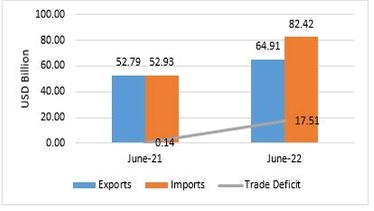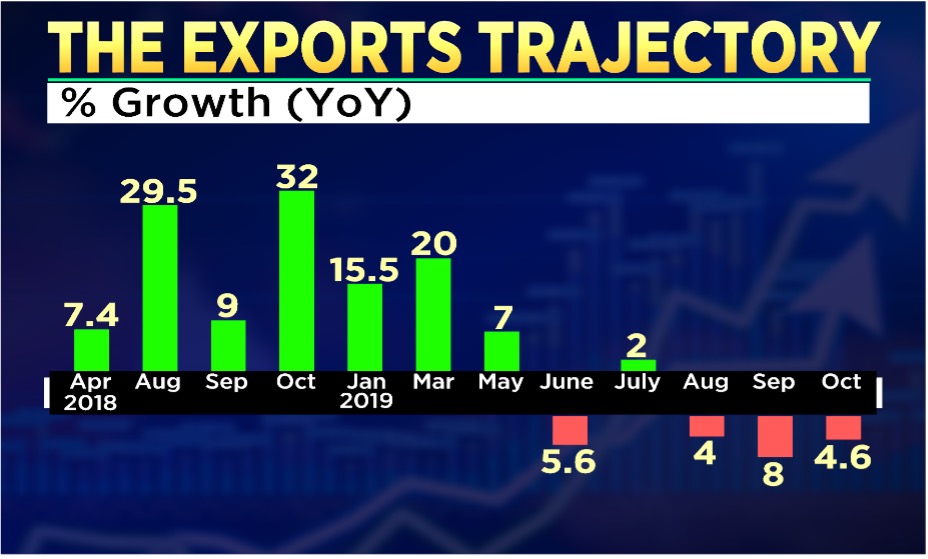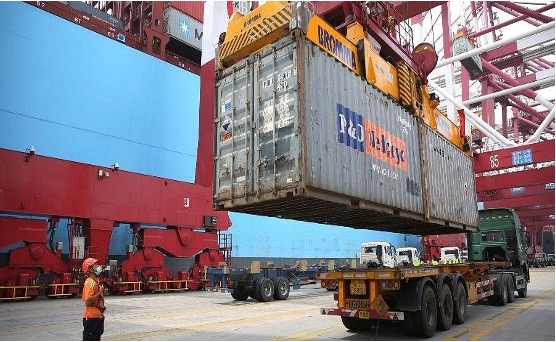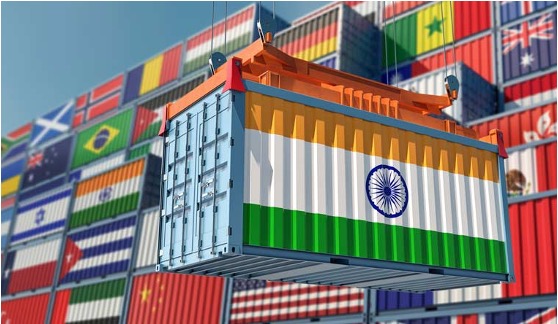India has witnessed significant growth in its export performance over the years. In the fiscal year 2019-2020, India’s total merchandise exports reached USD 314.31 billion, showcasing a substantial increase from USD 303.53 billion in the previous fiscal year. This growth reflected India’s expanding presence in the global market but it started to decline by 10.3% To $34.98 Bn in 2021. India’s exports in the month of May declined 10.3 percent to $34.98 billion while imports fell 6.6 percent to $57.1 billion. India’s export sector, which has historically been a significant driver of economic growth, is currently facing a worrisome trend of declining exports. India’s overall trade deficit increased to $17.15 billion last month, up from $0.14 billion in June 2021, according to the data released by the government. Trade deficit refers to a situation where a country’s imports of goods and services exceed its exports. In other words, it occurs when the value of a country’s imports is higher than the value of its exports during a specific period, typically measured on an annual basis. A trade deficit represents a negative balance of trade and is often expressed in monetary terms.

This decline has raised concerns about the country’s ability to sustain its economic momentum and compete in the global market. In recent years, India has experienced a decrease in its export performance due to factors such as the global economic slowdown, the impact of the COVID-19 pandemic, currency fluctuations, and trade barriers. These challenges have resulted in a notable decline in India’s total export value, affecting key sectors like textiles, engineering goods, gems and jewelry, and automobiles. Analyzing the facts and figures associated with India’s declining exports provides valuable insights into the severity of the issue and underscores the need for strategic interventions to revive and strengthen the export sector for sustained economic growth.
India’s exports declined by about 16.7% in October 2022 compared to what it did in October 2021. India’s export sector has traditionally been a key driver of its economic growth, contributing to job creation, foreign exchange earnings, and industrial development. Several factors have contributed to India’s declining exports, including:
Global Economic Slowdown: The global economy has experienced a slowdown, impacting demand for goods and services worldwide. Reduced consumer spending, trade tensions, and geopolitical uncertainties have adversely affected India’s export performance. The global economic slowdown is a complex phenomenon influenced by multiple factors, with India’s declining exports being one component. India’s declining exports have contributed to a slowdown in global trade growth. According to the World Trade Organization (WTO), global merchandise trade volume growth declined by 5.3% in 2019, with India’s exports being one of the contributing factors. This decline in trade growth impacted the overall global economic expansion. It can lead to trade imbalances between countries, which can hurt the global economy.
As India’s exports decrease, it may result in a higher trade deficit for the country, while importing countries may experience reduced export opportunities. This imbalance affects the stability of international trade and can contribute to a slowdown in economic growth. This can disrupt global supply chains, affecting multiple countries and industries. India is a major exporter of various goods and services, including textiles, pharmaceuticals, and IT services. Disruptions in these supply chains due to declining exports can lead to production delays, increased costs, and reduced efficiency, ultimately impacting the overall global economic activity. India’s declining exports have a ripple effect on its trading partners, which can contribute to the global economic slowdown. Many countries rely on India as a significant source of imports, and a decline in India’s exports affects their supply chain and production processes. This impact can further weaken economic growth globally. This can impact investor sentiment and market confidence, influencing investment decisions globally. Investors closely monitor export trends as they provide insights into a country’s economic health.

A decline in India’s exports may raise concerns among investors, affecting their confidence in the global economic outlook. It can also result in job losses and unemployment, both domestically and internationally. The export sector is a major source of employment, and a decline in exports can lead to layoffs and reduced hiring in export-oriented industries. This, in turn, affects consumer spending, business investments, and overall economic activity. It is important to note that while India’s declining exports contribute to the global economic slowdown, they are not the sole factor. Other factors, such as trade tensions between major economies, geopolitical uncertainties, and the impact of other countries’ export performance, also play significant roles.
COVID-19 Pandemic: The outbreak of the COVID-19 pandemic has caused disruptions in global supply chains, leading to a decrease in export volumes. Lockdown measures, travel restrictions, and reduced consumer demand have severely impacted various sectors, including textiles, gems and jewelry, and automobiles. The imposition of lockdown measures to control the spread of the virus led to the temporary closure of factories, restrictions on movement, and disruptions in logistics and transportation. The disruptions in global supply chains impacted manufacturing activities, hindering the production and export of goods from India.
The textile and garment industry, a major contributor to India’s exports, faced significant challenges. In the fiscal year 2020-2021, textile and garment exports declined by around 28% to USD 27.24 billion compared to the previous year. India’s gems and jewelry sector, known for its craftsmanship and global demand, witnessed a decline in exports. In the fiscal year 2020-2021, gems and jewelry exports fell by around 35% to USD 22.41 billion compared to the previous year. India’s engineering goods sector also experienced a decline in exports. In the fiscal year 2020-2021, engineering goods exports decreased by around 13% to USD 66.55 billion compared to the previous year. There was a disruption in logistics and transportation too. The reduction in passenger flights, which carry a significant portion of air cargo, led to a decrease in air freight capacity, impacting the movement of goods. The pandemic disrupted the availability of shipping containers, causing delays and increased costs for exporters.

The demand for essential goods such as pharmaceuticals and medical equipment increased during the pandemic. However, other sectors reliant on non-essential consumer goods experienced a decline in demand. India’s automotive sector faced challenges as demand weakened globally. In the fiscal year 2020-2021, automotive exports declined by around 21% to USD 15.9 billion compared to the previous year. The Indian government introduced various initiatives, including the Atmanirbhar Bharat Abhiyan (Self-Reliant India Campaign), to support domestic industries and promote exports. The COVID-19 pandemic and the resulting disruptions in global trade and supply chains have significantly contributed to India’s declining exports. The decline in export volumes across sectors disrupted logistics and transportation, and shifts in demand and consumer preferences have all played a role. While the situation is gradually improving with the easing of restrictions, the recovery of India’s export sector remains a priority for sustainable economic growth.
Currency Fluctuations: Fluctuations in the value of the Indian rupee against major currencies can affect export competitiveness. A stronger rupee makes Indian goods relatively more expensive for foreign buyers, thus impacting export volumes. This reduction in price competitiveness can lead to a decrease in export volumes as foreign buyers seek more affordable alternatives from other countries. Many export-oriented industries, such as textiles, garments, and low-cost manufacturing, operate on thin profit margins. Currency appreciation can significantly impact their profitability and competitiveness in international markets.
The USD-INR exchange rate is a key indicator of currency fluctuations impacting India’s exports. Over the years, the exchange rate has fluctuated, impacting export competitiveness. In 2019, the USD-INR exchange rate ranged from around 68.50 to 75.00 INR. A stronger Indian rupee against the US dollar during this period could have affected the competitiveness of Indian exports. When the Indian rupee strengthens against major currencies, such as the US dollar orthe euro, the value of export earnings in rupee terms decreases. This can negatively impact export revenue, especially when the volume of exports remains unchanged or declines. This reduction in export earnings can contribute to the decline in India’s overall export performance. Currency fluctuations not only impact India’s export competitiveness but also affect its position relative to other countries. When the Indian rupee strengthens against the currencies of competing exporting nations, it can further erode India’s competitiveness in global markets. If the currencies of other exporting countries, such as China or Vietnam, depreciate against major currencies while the Indian rupee appreciates, it puts Indian exporters at a disadvantage in terms of pricing and competitiveness.

The Reserve Bank of India (RBI) actively monitors and intervenes in the foreign exchange market to manage excessive volatility and stabilize the currency. However, the effectiveness of these interventions in curbing currency fluctuations and their impact on exports can vary. Exporters can use hedging instruments such as forward contracts and options to mitigate the risks associated with currency fluctuations. These mechanisms provide a certain level of stability by allowing exporters to fix exchange rates for future transactions.
Trade Barriers: Trade barriers have had a significant impact on India’s declining exports, limiting market access, and hindering the competitiveness of Indian goods in international markets. Tariffs are taxes imposed on imported goods, increasing their cost, and making them less competitive in foreign markets. Higher tariff rates on Indian exports can reduce demand and hinder export growth. In 2018, India faced higher tariff rates on several products in key export markets. For instance, the US imposed tariffs on Indian steel and aluminium, impacting India’s exports in these sectors. Non-tariff barriers include various technical regulations, standards, and certification requirements imposed by importing countries. These can create obstacles for Indian exporters, especially small and medium-sized enterprises (SMEs) that may find it challenging to meet these requirements. Non-tariff barriers in the form of stringent food safety regulations in certain markets have affected India’s agricultural exports, such as fruits and vegetables.
Protectionist measures, including import quotas, local content requirements, and import substitution policies, can limit market access for Indian exporters and favor domestic industries. Some countries have implemented import substitution policies in sectors like electronics and automobiles, creating barriers to Indian exports in these industries. Heightened trade tensions between major economies can result in retaliatory measures, including increased tariffs or trade restrictions. These actions can adversely impact India’s exports and disrupt global trade. Trade tensions between the US and China have led to retaliatory measures affecting various countries, including India. The resulting trade disruptions can contribute to the decline in India’s exports. It can restrict India’s access to new and emerging markets, hampering export diversification efforts. Limited market access hampers the growth potential of Indian exporters in untapped markets. India’s efforts to enhance market access in sectors like pharmaceuticals, IT services, and agricultural products have faced challenges due to trade barriers in certain countries.
Negotiating and implementing Free Trade Agreements (FTAs) and Preferential Trade Agreements (PTAs) can provide improved market access and reduced trade barriers. India’s participation in such agreements can help mitigate the impact of trade barriers on its exports. India has signed FTAs and PTAs with countries like Japan, South Korea, and ASEAN nations to enhance trade relations and reduce barriers. Addressing trade barriers through negotiations, participation in trade agreements, and advocacy for fair trade practices remains essential to revive India’s export growth.

Geographical Distribution: India’s exports are distributed across various regions, highlighting the country’s efforts to diversify its export markets. United States: India’s exports to the United States, one of its major markets, were adversely affected. In the fiscal year 2020-2021, exports to the US declined by around 6.5% to USD 52.49 billion compared to the previous year.
European Union: Exports to the European Union also experienced a decline. In the fiscal year 2020-2021, exports to the EU fell by around 13% to USD 44.86 billion compared to the previous year.
Government Initiatives and Future Outlook: The Indian government has recognized the importance of reviving the export sector and has taken several initiatives to address the challenges. These include promoting ease of doing business, implementing trade facilitation measures, expanding market access through free trade agreements, and providing financial incentives to exporters. Despite the current challenges, there are potential opportunities for India’s export sector. The government’s emphasis on diversifying export markets, focusing on high-value products, and leveraging emerging sectors like information technology, pharmaceuticals, and renewable energy can help revive India’s export growth.

India’s declining exports pose significant challenges to the country’s economic growth and development. Various factors, including the global economic slowdown, the COVID-19 pandemic, currency fluctuations, and trade barriers, have contributed to this decline. Analyzing export figures provides a clearer understanding of the sector-wise performance and the impact on specific markets. However, with government initiatives and a focus on emerging sectors, there is potential for India to regain its export momentum and contribute to a robust economic recovery.
Written by – Anshika Gupta
Edited by – Rajan Patel
